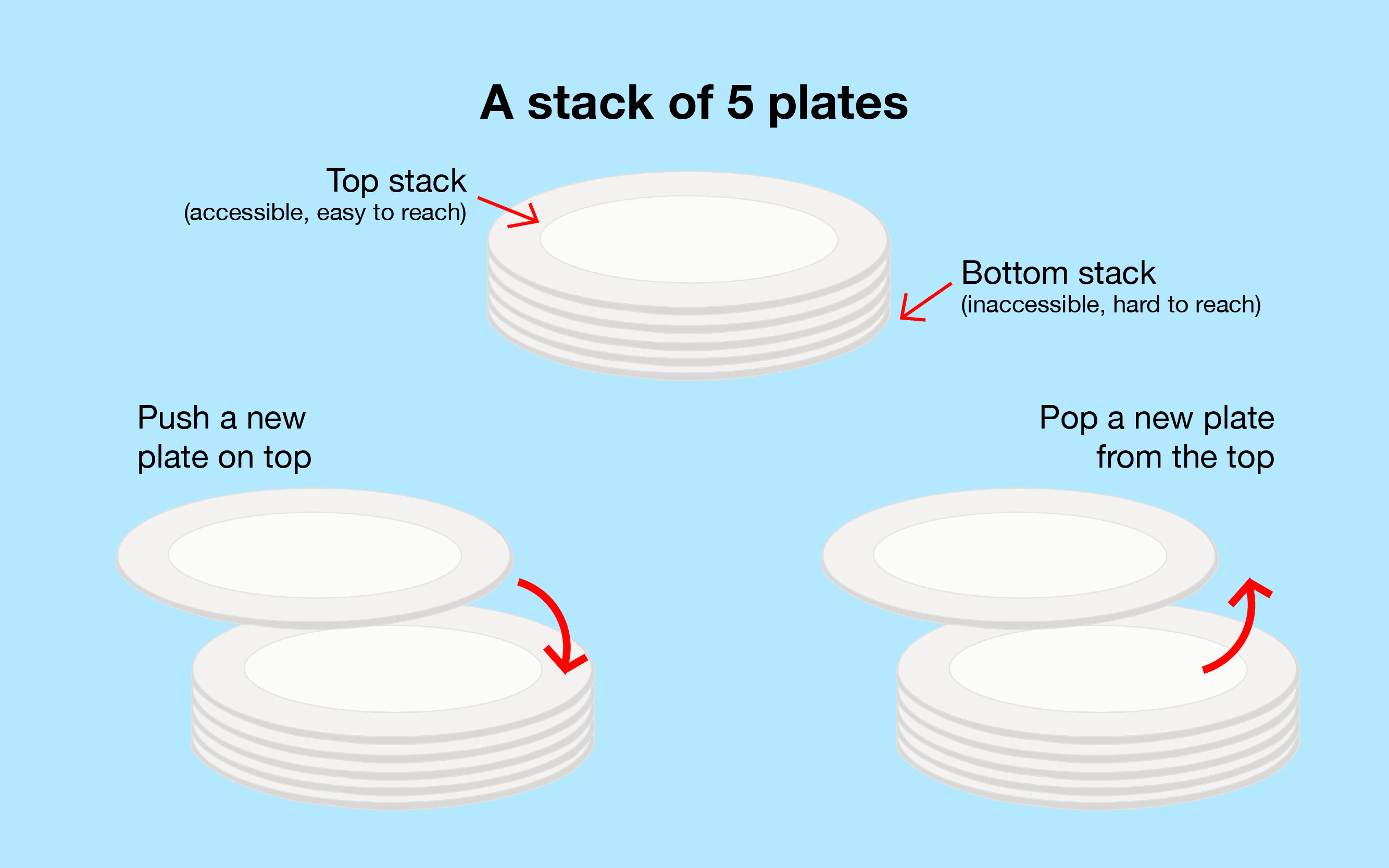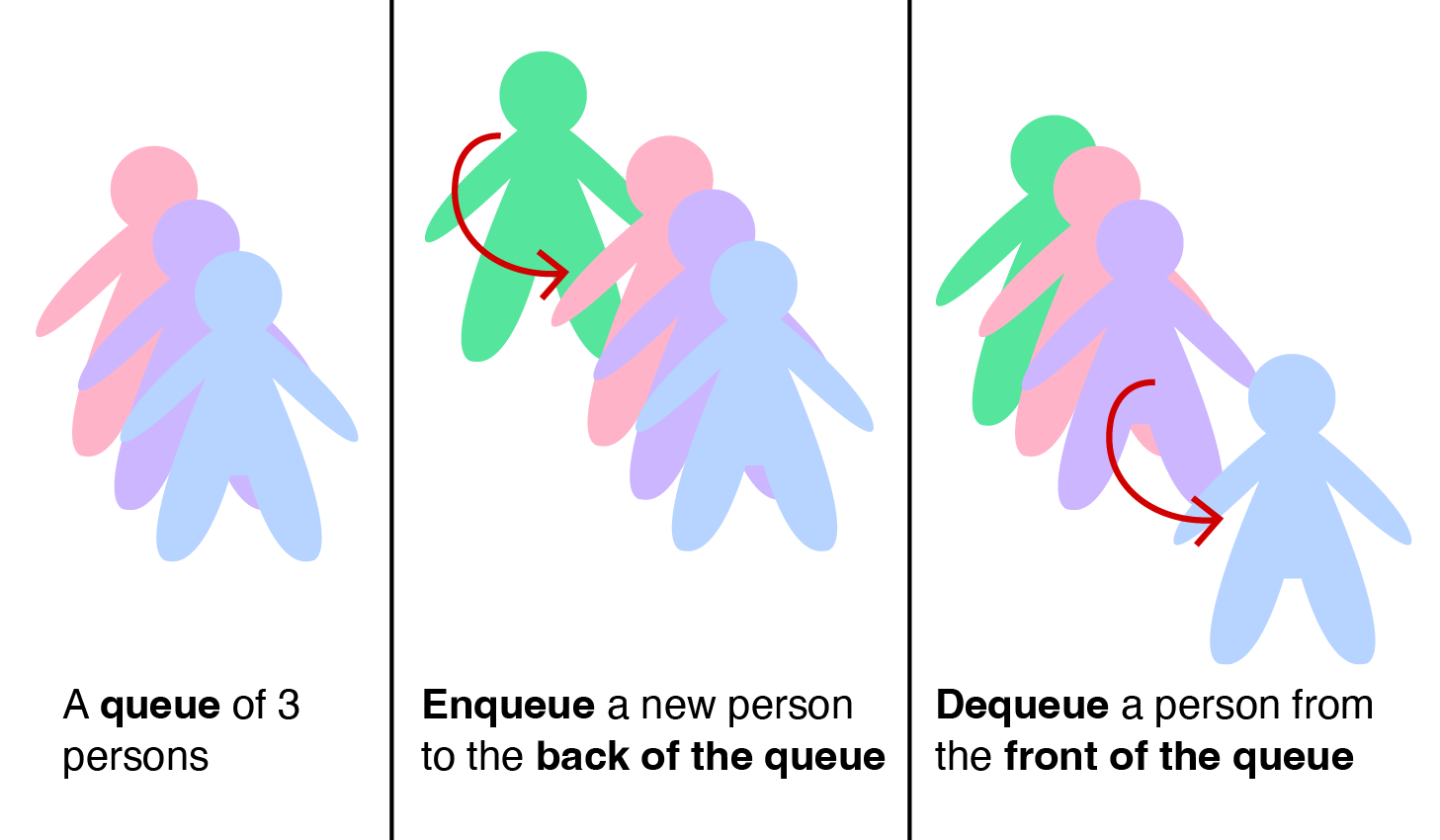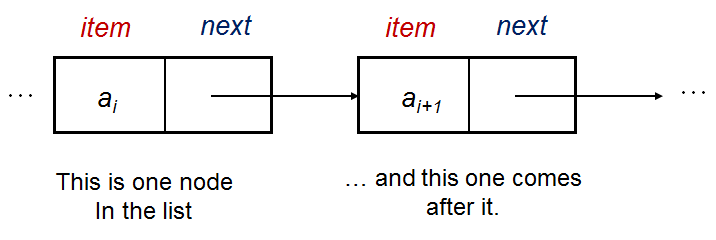







Linked List is a data structure consisting of a group of vertices (nodes) which together represent a sequence. Under the simplest form, each vertex is composed of a data and a reference (link) to the next vertex in the sequence. Try clicking for a sample animation on searching a value in a (Singly) Linked List.
Linked List (and its variations) can be used as the underlying data structure to implement List, Stack, Queue, and Deque ADTs (read this Wikipedia article about ADT if you are not familiar with that term). Another potential data structure that can be used to implement List ADT is (resize-able) array.
In this visualization, we discuss (Singly) Linked List (LL) — with a single next pointer — and its two variants: Stack and Queue, and also Doubly Linked List (DLL) — with both next and previous pointers — and its variant: Deque.
Remarks: By default, we show e-Lecture Mode for first time (or non logged-in) visitor.
If you are an NUS student and a repeat visitor, please login.
Pro-tip 1: Since you are not logged-in, you may be a first time visitor (or not an NUS student) who are not aware of the following keyboard shortcuts to navigate this e-Lecture mode: [PageDown]/[PageUp] to go to the next/previous slide, respectively, (and if the drop-down box is highlighted, you can also use [→ or ↓/← or ↑] to do the same),and [Esc] to toggle between this e-Lecture mode and exploration mode.
- 它是一个简单的线性数据结构。
- 做为一个抽象数据类型,它有很广泛的应用。比如,学生名单,活动清单,约会清单等(尽管还有其他更高级的数据结构可以更好地完成相同的应用程序),也可以用来实现堆栈/队列/ 双端队列。
- 有些比较特殊的情况来说明为什么需要选择一个合适的数据结构去实现你的目的。
- 它具有各种定制的方式,因此通常在面向对象编程(OOP)中来教这种链表数据结构。
Pro-tip 2: We designed this visualization and this e-Lecture mode to look good on 1366x768 resolution or larger (typical modern laptop resolution in 2021). We recommend using Google Chrome to access VisuAlgo. Go to full screen mode (F11) to enjoy this setup. However, you can use zoom-in (Ctrl +) or zoom-out (Ctrl -) to calibrate this.
列表是一个项目/数据的序列,其中位置顺序很重要 {a0, a1, ..., aN-2, aN-1}。
常见的列表ADT操作包括:
- get(i) — 可能是一个微不足道的操作,返回 ai (0-based indexing),
- search(v) — 判断项目/数据 v 是否存在(并报告其位置/索引)
或者不存在(通常报告一个不存在的索引 -1)在列表中, - insert(i, v) — 在列表中的位置/索引 i 处插入项目/数据 v,可能会将前面的项目:[i..N-1] 向右移动一个位置以腾出空间,
- remove(i) — 移除列表中位置/索引 i 处的项目,可能会将前面的项目:[i+1..N-1] 向左移动一个位置以填补空白。
讨论1:如果我们想从列表中移除具有特定值 v 的项目怎么办?
讨论2:一个列表ADT可以包含重复的项目吗,即,ai = aj 其中 i ≠ j?
Pro-tip 3: Other than using the typical media UI at the bottom of the page, you can also control the animation playback using keyboard shortcuts (in Exploration Mode): Spacebar to play/pause/replay the animation, ←/→ to step the animation backwards/forwards, respectively, and -/+ to decrease/increase the animation speed, respectively.
The content of this interesting slide (the answer of the usually intriguing discussion point from the earlier slide) is hidden and only available for legitimate CS lecturer worldwide. This mechanism is used in the various flipped classrooms in NUS.
If you are really a CS lecturer (or an IT teacher) (outside of NUS) and are interested to know the answers, please drop an email to stevenhalim at gmail dot com (show your University staff profile/relevant proof to Steven) for Steven to manually activate this CS lecturer-only feature for you.
FAQ: This feature will NOT be given to anyone else who is not a CS lecturer.
Please review (Compact) Array data structure that can also be used to implement List ADT.
For fixed-size collections with known max limit of number of items that will ever be needed, i.e., the max size of M, then array is already a reasonably good data structure for List ADT implementation.
For variable-size collections with unknown size M and where dynamic operations such as insert/remove are common, a simple (fixed-size) array is actually a poor choice of data structure.
For such applications, there are better data structures, including Linked List. Read on...
在其基本形式中,链表中的单个顶点(节点)具有这种粗略的结构:
struct Vertex { // 我们可以使用C struct或C++/Python/Java 中的 class
int item; // 数据存储在这里,这个例子中是一个整数
Vertex* next; // 这个指针告诉我们下一个顶点在哪里
};使用默认示例链表 [22 (头)->2->77->6->43->76->89 (尾)] 进行说明,我们有:
a0 其中的 item = 22 和它的 next = a1,
a1 其中的 item = 2 和它的 next = a2,
...
a6 其中的 item = 89 和它的 next = null。
讨论:对于C++实现的链表来说,struct还是class更好?Python或Java实现呢?
The content of this interesting slide (the answer of the usually intriguing discussion point from the earlier slide) is hidden and only available for legitimate CS lecturer worldwide. This mechanism is used in the various flipped classrooms in NUS.
If you are really a CS lecturer (or an IT teacher) (outside of NUS) and are interested to know the answers, please drop an email to stevenhalim at gmail dot com (show your University staff profile/relevant proof to Steven) for Steven to manually activate this CS lecturer-only feature for you.
FAQ: This feature will NOT be given to anyone else who is not a CS lecturer.
我们还在这个链表数据结构中记住了一些额外的数据。我们使用默认示例链表 [22 (头)->2->77->6->43->76->89 (尾)] 进行说明。
- 头 指针指向 a0 — 它是 22,没有东西指向头部项,
- 链表中元素的当前数量 N — N = 7 个元素。
- 尾 指针指向 aN-1 — 它是 a6 = 89,尾部项后面没有东西。
就是这样,我们只在数据结构中添加了三个额外的变量。
请注意,许多计算机科学教科书中关于如何实现(单向)链表有各种微妙的差异,例如,是否使用尾指针,是否循环,是否使用虚拟头部项,是否允许重复项 — 参见此幻灯片。
我们在这个可视化中的版本(带有尾指针,非循环,无虚拟头部,不允许重复)可能与你在课堂上学到的内容不完全相同,但基本的思想应该是相同的。
在这个可视化中,每个顶点都有整数项,但这可以根据需要轻松更改为任何其他数据类型。
由于我们只保留头部和尾部指针,需要列表遍历子程序才能到达头部(索引0)和尾部(索引N-1)以外的位置。
由于这个子程序使用频繁,我们将其抽象为一个函数。下面的代码是用C++编写的。
Vertex* Get(int i) { // 返回顶点
Vertex* ptr = head; // 我们必须从头开始
for (int k = 0; k < i; ++k) // 向前推进 i 次
ptr = ptr->next; // 指针指向更高的索引
return ptr;
}它的运行时间为 O(N),因为i可以大到索引N-2。
将此与数组进行比较,我们可以在 O(1) 时间内访问索引 i。
- 在上面的的例子中找到位置/索引2(基于0的索引)。
- 在上面的示例中检查完所有的N项之后,我们发现没有找到。因此在最坏情况下search(v)的时间复杂度O(n)。
由于链表的性质,比数组版本有更多的情况。
大多数第一次学习链表的计算机科学学生通常在他们的链表代码失败时才意识到所有的情况。
在这个电子讲座中,我们直接详细说明所有的情况。
对于insert(i, v),有四种可能性,即,项目v被添加到:
- 链表的头部(在当前第一项之前),i = 0,
- 一个空的链表(幸运的是,这与前一种情况相似),
- 链表的最后一项(当前尾部)之后的位置,i = N,
- 链表的其他位置,i = [1..N-1]。
在头部插入的 (C++) 代码既简单又高效,时间复杂度为 O(1):
Vertex* vtx = new Vertex(); // 从项 v 创建新顶点 vtx
vtx->item = v;
vtx->next = head; // 将这个新顶点链接到(旧的)头顶点
head = vtx; // 新顶点成为新的头部
尝试 ,即 insert(0, 50),在示例链表 [22 (head)->2->77->6->43->76->89 (tail)] 上。
讨论:如果我们使用数组实现来在列表的头部插入,会发生什么?
The content of this interesting slide (the answer of the usually intriguing discussion point from the earlier slide) is hidden and only available for legitimate CS lecturer worldwide. This mechanism is used in the various flipped classrooms in NUS.
If you are really a CS lecturer (or an IT teacher) (outside of NUS) and are interested to know the answers, please drop an email to stevenhalim at gmail dot com (show your University staff profile/relevant proof to Steven) for Steven to manually activate this CS lecturer-only feature for you.
FAQ: This feature will NOT be given to anyone else who is not a CS lecturer.
空的数据结构是一个常见的角落/特殊情况,如果没有适当的测试,往往会导致意外的崩溃。在当前为空的列表中插入新项是合法的,即在索引 i = 0 处。幸运的是,插入头部的同样的伪代码也适用于空列表,所以我们可以像在这个幻灯片中一样使用相同的代码(有一个小改动,我们还需要设置 tail = head)。
尝试 ,即 insert(0, 50),但在空的链表 [] 上。
Vertex* pre = Get(i-1);/ /遍历到第(i-1)个节点,O(n)
aft = pre.next//aft不能为null
也尝试一下,这一个极端情况:插入尾部的位置,把尾部指针移到右边的一个位置。由于需要遍历列表(例如,如果i接近n-1),这个操作很缓慢的,O(n)。
如果我们也记住尾指针,就像在这个电子讲座中的实现一样(这是建议的,因为它只是一个额外的指针变量),我们可以在尾部项目之后(在i = N)有效地执行插入,时间复杂度为O(1):
Vertex* vtx = new Vertex(); // 这也是一个 C++ 代码
vtx->item = v; // 从项目 v 创建新的顶点 vtx
tail->next = vtx; // 只需链接这个,因为尾部是 i = (N-1)-th 项目
tail = vtx; // 现在更新尾指针
尝试 ,即 insert(7, 10),在示例链表 [22 (head)->2->77->6->43->76->89 (tail)] 上。一个常见的误解是说这是在尾部插入。在尾部元素插入是 insert(N-1, v)。在尾部之后插入是 insert(N, v)。
讨论:如果我们使用数组实现对列表尾部之后的插入会发生什么?
The content of this interesting slide (the answer of the usually intriguing discussion point from the earlier slide) is hidden and only available for legitimate CS lecturer worldwide. This mechanism is used in the various flipped classrooms in NUS.
If you are really a CS lecturer (or an IT teacher) (outside of NUS) and are interested to know the answers, please drop an email to stevenhalim at gmail dot com (show your University staff profile/relevant proof to Steven) for Steven to manually activate this CS lecturer-only feature for you.
FAQ: This feature will NOT be given to anyone else who is not a CS lecturer.
对于 remove(i),有三种(合法)可能性,即,索引 i 是:
- 链表的头部(当前的第一项),i = 0,它会影响头指针
- 链表的尾部,i = N-1,它会影响尾指针
- 链表的其他位置,i = [1..N-2]。
讨论:将此幻灯片与插入情况幻灯片进行比较,以了解微妙的差异。从已经为空的链表中删除任何东西是否被认为是'合法'的?
这个案例很直接(用C++编写):
if (head == NULL) return; // 当 SLL 为空时避免崩溃
Vertex* tmp = head; // 这样我们可以稍后删除它
head = head->next; // 记账,更新头指针
delete tmp; // 这是旧的头部
尝试在链表 [22 (head)->2->77->6 (tail)] 上反复使用 。它将一直正确工作,直到链表只包含一个项目,即头部 = 尾部项目。如果 LL 已经为空,我们将阻止执行,因为这是一个非法的情况。
讨论:如果我们使用数组实现来移除列表的头部会发生什么?
The content of this interesting slide (the answer of the usually intriguing discussion point from the earlier slide) is hidden and only available for legitimate CS lecturer worldwide. This mechanism is used in the various flipped classrooms in NUS.
If you are really a CS lecturer (or an IT teacher) (outside of NUS) and are interested to know the answers, please drop an email to stevenhalim at gmail dot com (show your University staff profile/relevant proof to Steven) for Steven to manually activate this CS lecturer-only feature for you.
FAQ: This feature will NOT be given to anyone else who is not a CS lecturer.
Vertex* pre = Get(i-1);/ /遍历到第(i-1)节点,O(n)
Vertex* del = pre->next, aft = del->next;
我们可以按照以下方式实现链表尾部的移除,假设链表有多于1个项目(在C++中):
Vertex* pre = head;
tmp = head->next;
while (tmp->next != null) // 当邻居不是尾部时
pre = pre->next, tmp = tmp->next;
pre->next = null;
delete tmp; // tmp = (旧) 尾部
tail = pre; // 更新尾部指针
尝试在链表 [22 (头部)->2->77->6 (尾部)] 上反复使用 。它将一直正确工作,直到链表只包含一个项目,头部 = 尾部项目,我们切换到头部移除的情况。如果链表已经为空,我们将阻止执行,因为这是一个非法的情况。
The content of this interesting slide (the answer of the usually intriguing discussion point from the earlier slide) is hidden and only available for legitimate CS lecturer worldwide. This mechanism is used in the various flipped classrooms in NUS.
If you are really a CS lecturer (or an IT teacher) (outside of NUS) and are interested to know the answers, please drop an email to stevenhalim at gmail dot com (show your University staff profile/relevant proof to Steven) for Steven to manually activate this CS lecturer-only feature for you.
FAQ: This feature will NOT be given to anyone else who is not a CS lecturer.
search(v)在最佳情况下,v在第一位置中找到, O(1)。在最坏的情况下,在列表中没有发现v,并且我们需要O(n)扫描来确定。
删除(i)在最佳情况下,删除i=0,头指针帮助,O(1)。在最坏的情况下,在i=n-1处删除,因为需要更新尾指针O(n)。
然而,允许顶点在内存中不连续的链表的基本概念,让堆栈 和 队列.的可以成为一个极好的可调整大小的数据结构。
栈是一种特殊的抽象数据类型,其主要操作是向集合添加一个项目,称为推入,只能推入到栈顶,以及从栈顶移除一个项目,称为弹出。
它被称为后进先出(LIFO)数据结构,例如,下面的书堆。

在大多数实现中,以及在这个可视化中,栈基本上是一个受保护的(单向)链表,我们只能查看头部项目,只能向头部推送新项目(在头部插入),例如,尝试 ,并且只能从头部弹出现有项目(从头部移除),例如,尝试 。所有操作都是 O(1)。
在这个可视化中,我们将(单)链表从上到下定向,头/尾项目分别在顶部/底部。在示例中,我们有 [2 (顶部/头部)->7->5->3->1->9 (底部/尾部)]。由于垂直屏幕大小限制(在横向模式下),我们在这个可视化中只允许最多7个项目的栈。
讨论:我们能否使用向量,一个可调整大小的数组,来有效地实现栈ADT?
The content of this interesting slide (the answer of the usually intriguing discussion point from the earlier slide) is hidden and only available for legitimate CS lecturer worldwide. This mechanism is used in the various flipped classrooms in NUS.
If you are really a CS lecturer (or an IT teacher) (outside of NUS) and are interested to know the answers, please drop an email to stevenhalim at gmail dot com (show your University staff profile/relevant proof to Steven) for Steven to manually activate this CS lecturer-only feature for you.
FAQ: This feature will NOT be given to anyone else who is not a CS lecturer.
栈有一些受欢迎的教科书应用程序。一些例子:
- 括号匹配,
- 后缀计算器,
- 一些其他有趣的应用程序,出于教学目的没有显示。
数学表达式可能会变得相当复杂,例如,{[x+2]^(2+5)-2}*(y+5)。
括号匹配问题是检查给定输入中的所有括号是否正确匹配的问题,即,( 与 ),[ 与 ] 和 { 与 },等等。
括号匹配对于检查源代码的合法性同样有用。
讨论:事实证明,我们可以使用栈的LIFO行为来解决这个问题。
问题是如何做到这一点?
The content of this interesting slide (the answer of the usually intriguing discussion point from the earlier slide) is hidden and only available for legitimate CS lecturer worldwide. This mechanism is used in the various flipped classrooms in NUS.
If you are really a CS lecturer (or an IT teacher) (outside of NUS) and are interested to know the answers, please drop an email to stevenhalim at gmail dot com (show your University staff profile/relevant proof to Steven) for Steven to manually activate this CS lecturer-only feature for you.
FAQ: This feature will NOT be given to anyone else who is not a CS lecturer.
例如,表达式2 3 + 4 *是(2 +3)*4的后缀版本。
在后缀表达式中,我们不需要括号。
讨论:我们还可以使用堆栈来有效地解决这个问题。那如何呢?
The content of this interesting slide (the answer of the usually intriguing discussion point from the earlier slide) is hidden and only available for legitimate CS lecturer worldwide. This mechanism is used in the various flipped classrooms in NUS.
If you are really a CS lecturer (or an IT teacher) (outside of NUS) and are interested to know the answers, please drop an email to stevenhalim at gmail dot com (show your University staff profile/relevant proof to Steven) for Steven to manually activate this CS lecturer-only feature for you.
FAQ: This feature will NOT be given to anyone else who is not a CS lecturer.

这是因为在紧凑数组后面的插入速度很快,O(1),但是由于需要移位项目,所以在紧凑数组前面的移除是慢的,请查看此幻灯片。
另一种可能的数组实现方法是通过使用两个索引来避免在出队操作中的项目移动:front(队列最前面的项目的索引,在出队操作后增加)和back(队列最后面的项目的索引,在入队操作后也增加)。
假设我们使用一个大小为M = 8的数组,我们的队列内容如下:[(2,4,1,7),-,-,-,-],其中front = 0(下划线)和back = 3(斜体)。当前活动的队列元素用(绿色)高亮显示。
如果我们调用 dequeue(),我们得到[-,(4,1,7),-,-,-,-],front = 0+1 = 1,和back = 3。
如果我们调用 enqueue(5),我们得到[-,(4,1,7,5),-,-,-],front = 1,和back = 3+1 = 4。
然而,经过许多出队和入队操作后,我们可能会有[-,-,-,-,-,6,2,3],front = 5,和back = 7。到现在为止,尽管数组前面有许多空位,但我们不能再入队任何其他元素。
如果我们允许front和back索引在达到索引M-1时“回绕”到索引0,我们实际上使数组“环形”,并且我们可以使用空位。
例如,如果我们接下来调用 enqueue(8),我们会有[8),-,-,-,-,(6,2,3],front = 5,和back = (7+1)%8 = 0。
然而,这并没有解决固定大小数组实现的主要问题。再进行几次入队操作后,我们可能会得到[8,10,11,12,13),(6,2,3],front = 5,和 back = 4。在这一点上(front = (back+1) % M)),我们不能再入队任何其他东西。
请注意,如果我们知道我们的队列大小永远不会超过固定数组大小M,那么循环数组的想法实际上已经是实现队列ADT的好方法。
然而,如果我们不知道队列大小的上限,我们可以扩大(加倍)数组的大小,例如,使M = 2*8 = 16(两倍大),但这将需要重新复制索引front到back的项目,这是一个慢(但罕见)的O(N)过程,得到[(6,2,3,8,10,11,12,13),-,-,-,-,-,-,-,-,],front = 0,和 back = 7。
PS1:如果你理解摊销分析,这个在循环数组满时的重大O(N)成本实际上可以分摊出来,使得每个入队在摊销意义上仍然是O(1)。
PS2:有一种使用两个栈来实现高效队列的替代方法。怎么做呢?
The content of this interesting slide (the answer of the usually intriguing discussion point from the earlier slide) is hidden and only available for legitimate CS lecturer worldwide. This mechanism is used in the various flipped classrooms in NUS.
If you are really a CS lecturer (or an IT teacher) (outside of NUS) and are interested to know the answers, please drop an email to stevenhalim at gmail dot com (show your University staff profile/relevant proof to Steven) for Steven to manually activate this CS lecturer-only feature for you.
FAQ: This feature will NOT be given to anyone else who is not a CS lecturer.
如果我们真的不知道队列大小的上限,那么单链表(SLL)可以是实现队列ADT的一个好的数据结构。
回想一下,在队列中,我们只需要列表的两个极端端点,一个只用于插入(入队),一个只用于移除(出队)。
如果我们回顾这张幻灯片,我们会看到在单链表中在尾部插入和从头部移除都很快,即,O(1)。因此,我们将单链表的头/尾指定为队列的前/后。然后,由于链表中的项目不是在计算机内存中连续存储的,我们的链表可以根据需要进行增长和缩小。
在我们的可视化中,队列基本上是一个受保护的单链表,我们只能查看头部项目,将新项目入队到当前尾部之后的一个位置,例如,尝试 ,并从头部出队现有项目,例如,尝试 (这本质上是一个出队操作)。所有操作都是O(1)。
在单链表中,即使我们通过尾指针直接访问尾元素,删除尾元素的主要问题是,我们必须在此类删除后更新尾指针,使其指向尾部之前的一个元素。
有了双链表向后移动的能力,我们可以通过tail->prev找到尾部之前的这个元素...因此,我们可以这样实现尾部的删除(在C++中):
Vertex* tmp = tail; // 记住尾部项
tail = tail->prev; // 实现 O(1) 性能的关键步骤 :O
tail->next = null; // 删除这个悬空的引用
delete tmp; // 删除旧的尾部
现在这个操作是 O(1)。尝试在示例 DLL [22 (head)<->2<->77<->6<->43<->76<->89 (tail)] 上使用 。
尝试 -附加步骤:22的PREV指针指向新的头50。
尝试 -附加步骤:10的PREV指针指向旧的尾部89。
尝试 -附加步骤:6 / 44的PREV指针分别指向44/77。
尝试 -将新的头2的PREV指针设置为NULL。
尝试 -将89的PREV指针设置为43。
创建操作对所有五种模式都是相同的。
然而,五种模式之间的搜索/插入/删除操作有些微小的差异。
对于栈,您只能从顶部/头部进行 peek/限制搜索,push/限制插入,和 pop/限制删除。
对于队列,您只能从前端(或有时是后端)进行 peek/限制搜索,从后端 push/限制插入,和从前端 pop/限制删除。
对于双端队列,您可以从前端/后端进行 peek/限制搜索,enqueue/限制插入,dequeue/限制删除,但不能从中间进行。
单向(单链)和双向链表没有这样的限制。
但是你可以提前阅读一些额外的挑战。
以下是关于链表的更高级的见解:
- 如果我们不存储尾指针会发生什么?
- 如果我们使用虚拟头部会怎样?
- 如果最后一个尾部项指回头部项会怎样?
- 需要做什么改变以允许重复项(更通用的列表ADT)?
The content of this interesting slide (the answer of the usually intriguing discussion point from the earlier slide) is hidden and only available for legitimate CS lecturer worldwide. This mechanism is used in the various flipped classrooms in NUS.
If you are really a CS lecturer (or an IT teacher) (outside of NUS) and are interested to know the answers, please drop an email to stevenhalim at gmail dot com (show your University staff profile/relevant proof to Steven) for Steven to manually activate this CS lecturer-only feature for you.
FAQ: This feature will NOT be given to anyone else who is not a CS lecturer.
- C++ STL:forward_list (单链表),堆栈 ,队列 (双链表),deque(实际上不使用双向链表,但另一种技术,看cppreference)
我们还有一些编程问题,这些问题在一定程度上需要使用链表,栈,队列或双端队列这些数据结构:
UVa 11988 - Broken Keyboard (又名 Beiju Text),
Kattis - backspace,和
Kattis - integerlists。
尝试它们以巩固和提高你对这种数据结构的理解。如果这可以简化你的实现,你可以使用 C++ STL,Python 标准库,或 Java API。
You have reached the last slide. Return to 'Exploration Mode' to start exploring!
Note that if you notice any bug in this visualization or if you want to request for a new visualization feature, do not hesitate to drop an email to the project leader: Dr Steven Halim via his email address: stevenhalim at gmail dot com.
新建(A)
搜索
插入
移除
